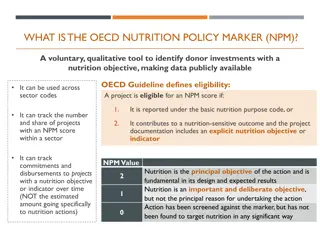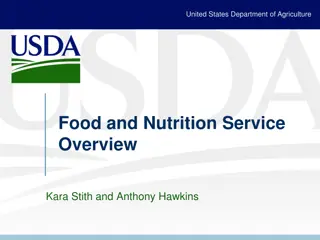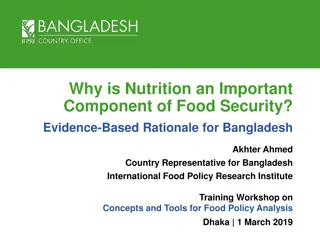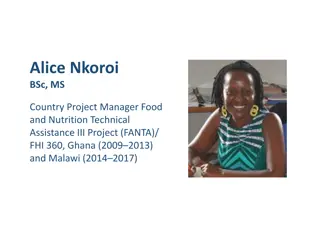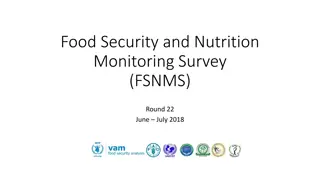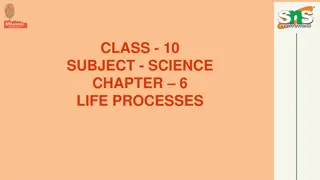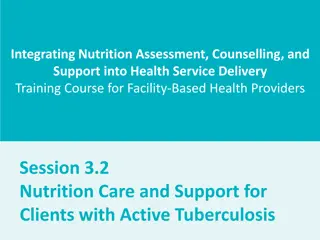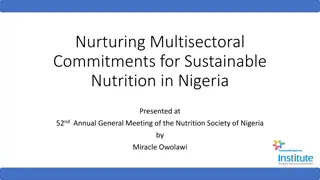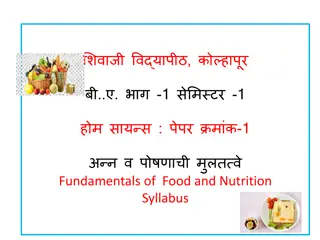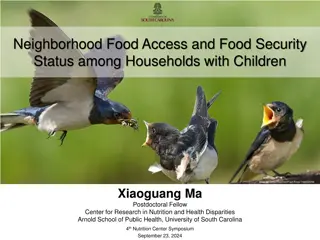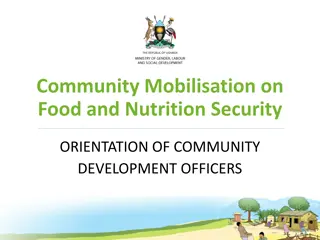Nutrition and Food Security
Addressing the concepts of famine, malnutrition, and food sources, this content explores the importance of balanced diets for human health, highlighting the role of essential nutrients and the impact of global dietary patterns. It also emphasizes the need for sustainable agriculture practices to ensure food security while minimizing environmental harm.
Download Presentation

Please find below an Image/Link to download the presentation.
The content on the website is provided AS IS for your information and personal use only. It may not be sold, licensed, or shared on other websites without obtaining consent from the author.If you encounter any issues during the download, it is possible that the publisher has removed the file from their server.
You are allowed to download the files provided on this website for personal or commercial use, subject to the condition that they are used lawfully. All files are the property of their respective owners.
The content on the website is provided AS IS for your information and personal use only. It may not be sold, licensed, or shared on other websites without obtaining consent from the author.
E N D
Presentation Transcript
Feeding the World Famine is the widespread malnutrition and starvation in an area due to a shortage of food, usually caused by a catastrophic event. Modern agriculture practices provide most of the world s population with enough food to survive. However, some of these practices can cause environmental damage that eventually makes growing food crops more difficult.
Humans and Nutrition The human body uses food both as a source of energy and as a source of materials for building and maintaining body tissues. The amount of energy that is available in food is expressed in Calories. One Calorie is equal to 1,000 calories or one kilocalorie.
Humans and Nutrition Malnutrition is a disorder of nutrition that results when a person does not consume enough of each of the nutrients that are needed by the human body. Humans need to get 8 essential amino acids from proteins. This is easily done if a variety of foods is eaten. However, in some parts of the world, the only sources of food may be corn and rice, which contain protein, but lacks one of the essential amino acids. Amino acid deficiency can result from such a limited diet.
Sources of Nutrition Diet is the type and amount of food that a person eats. A healthy diet is one that maintains a balance of the right amounts of nutrients, minerals, and vitamins. The foods produced in the greatest amounts worldwide are grains, plants of the grass family whose seeds are rich in carbohydrates. Besides eating grains, most people eat fruits, vegetables, and smaller amounts of meats, nuts, and other foods that are rich in fats and proteins.
Your Diet Record your diet. What did you eat all last week? Is it Organic? What could you change in your diet to be more health? What could you supply for yourself at your home with a garden? How much food (percent) do you waste off of your plate?
Diets Around the World People worldwide generally consume the same major nutrients and eat the same basic kinds of food. Diets vary by region. People in more developed countries tend to eat more food and a larger proportion of proteins and fats than people in less developed countries.
The Ecology of Food As the human population grows, farmland replaces forests and grasslands. Feeding everyone while maintaining natural ecosystems becomes increasingly difficult. Different kinds of agriculture have different environmental impacts and different levels of efficiency.
Farming Should farms produce crops for food or for energy. Groups of 4 (write down pros to your side of the argument)
Food Efficiency The efficiency of a given type of agriculture is a measure of the quantity of food produced on a given area of land with limited inputs of energy and resources. An ideal food crop is one that efficiently produces a large amount of food with little negative impact on the environment.
Food Efficiency On average, more energy, water, and land are used to produced a Calorie of food from animals than to produce a Calorie of food from plants.
Food Efficiency Thus, a given area of land can usually produce more food for humans when it is used to grow plants than when it is used to raise animals. The efficiency of raising plants for food is one reason why diets around the world are largely based on plants. However, meat from animals generally provides more nutrients per gram than most food from plants.
World Food Problems More food is needed each year to feed the world s growing population. World food production has been increasing for decades, but now food production is not increasing as fast as the human population is increasing.
The Green Revolution Worldwide, between 1950 and 1970, increases in crop yields resulted from the use of new crop varieties and the application of modern agriculture techniques. These changes were called the green revolution. Since the 1950s, the green revolution has changed the lives of millions of people.
The Green Revolution In addition, the green revolution had a negative impact on subsistence farmers, or farmers who grow only enough food for local use. Before the green revolution, subsistence farmers worked most of the world s farms. But they could not afford the equipment, water, ad chemicals needed to grow new crop varieties.









